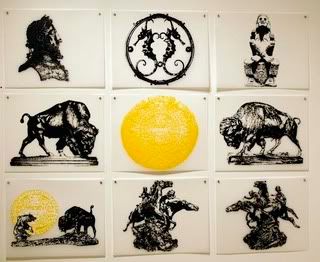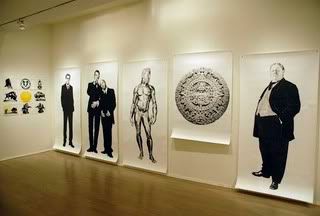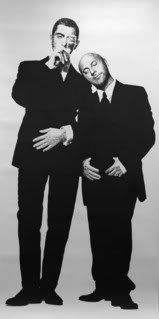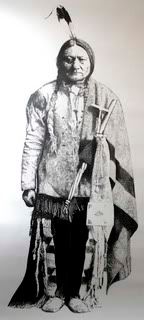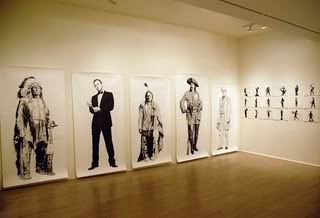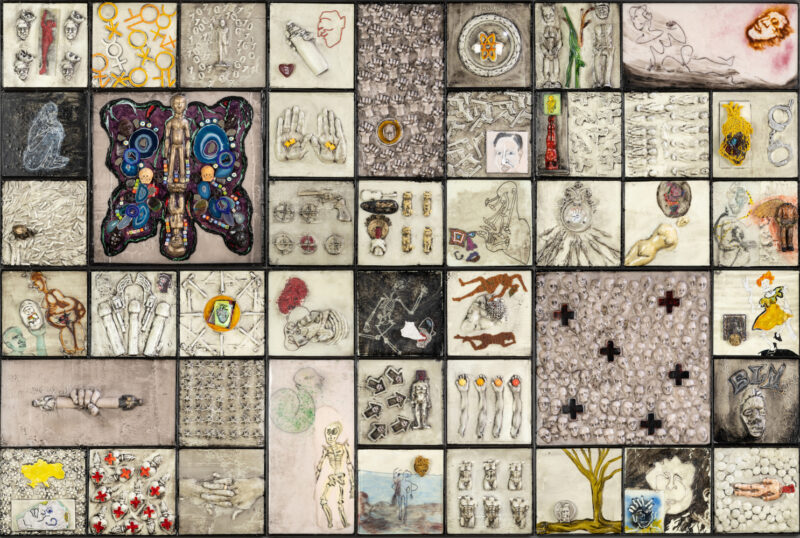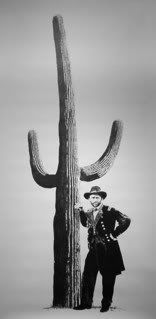
Generall Grant under a Saguaro
Re-telling has a way of distorting historical facts. In this way, historical analysis differs from reporting. To be effective to the modern sensibility, historical analysis needs to probe beyond the simple reporting of facts that have occurred. The modern reader wants to know what is essentially unknowable of historical figures: motivations, personality, inclinations and fears.
Treviño’s exhibition/installation at Grimaldis Gallery falls into the category of historical analysis. The large scale drawings of historical figures and a few modern ones stare out directly confronting the viewer with their own monumentality. The drawings are fastidiously detailed and rendered with tight graphite strokes from publicity images of their subjects. They are devoid of color or background. The viewer gaze upon these giants of history: Sitting Bull, Robert E. Lee, Howard Taft or U.S. Grant. Accompanying these figures are men from pop culture: Cary Grant, Dolce & Gabbana and the new Bond, Daniel Craig.
Treviño is a gay artist. That provides a key to unlocking and interacting with these large scale drawings that stare back. Treviño seems torn between the males that he respects and those that he wants to sleep with. Essentially it is a gallery of men to be objects for a queer gaze rather than the male gaze. Certainly George Custer is sexier than Sitting Bull!
General George Armstrong Custer’s perfumed ringlets of long blond hair and exotic buckskin fringe jacket cut a dashing figure in the mid-19th century. He was noted for his reckless cavalry charges and being promoted to brigadier general at the age of 23 during the Civil War. His recklessly foolish death at the hands of Native Americans was immortalized as Custer’s Last Stand. Who wouldn’t want to bed this man? His entire being oozes sexuality, sensuality and masculinity.
Sitting Bull’s face is lined by age and the hard life of a nomad of the Plains. There is no perfume in his hair. He is wrapped in an old blanket and old clothes made from hides. He doesn’t fight to seek glory but to protect what is left of his people’s way of life. Who doesn’t respect his desperate fight in the face of overwhelming odds? It is a fight doomed to fail and Sitting Bull is enshrined as an icon of that way of life that is gone. But does he match the sexual heat of Custer?
Treviño’s quandary is one of desire versus principal. As a gay Mexican-American, it seems wrong to desire Custer and rectify it with the historic actions of the man that borders on genocide. This quandary is what makes this work accessible to the viewer. Every person has to struggle between what we desire and what we sacrifice for that desire. To frame it as a historical equivalent of “whom would you rather do?” makes this installation compelling and sheds light on our own desires and pre-conceived notions. Robert E. Lee seems noble but untouchable while U.S. Grant seems earthily available. William Howard Taft seems grossly lecherous and Emilio Zapata seems comically forlorn.
Mixed in with these figures are images of pop culture icons. Because they are taken from carefully staged publicity pictures, they often feel the most desirable. Cary Grant and Daniel Craig have the presence that made them international sex symbols. However, they feel interchangeable and disposable. Daniel Craig is the new Bond but what happens when James Bond is inevitably recast? There is an attractive emptiness to these drawings. They seem more dedicated drawings of an overly obsessive fan even though they are created in the exact same manner as the historical figure drawings.
This is a ritualistic act of possession. By possessing the image of an object, we attempt to own a part of it. By creating it with our own hand we interact with the object of our fascination and connect it closer to us. Once again Treviño points us in the direction of desire. We desire celebrities because of what we perceive them to be. It can be shallow (Brad Pitt is really cut!) but we act out these rituals because we are compelled to. We are compelled by the desire to possess and consume.
The compelling part of this exhibition is how Treviño exposes his desires to the viewer and reveals part of his own psyche. By exposing himself, he takes the viewer along for the ride. We can also follow along through the smaller scale brain-map drawing installation on the rear wall also for good measure. The success of the exhibition is not determined by the quality of the drawings but rather determined by the desires that these icons stir up. The secret of historical analysis is that the subject never changes. Every generation gets the heroes or villains that they want to find. Every person who enters the public domain of celebrity is re-cast depending on who is looking at them. Treviño has created display upon which we project our thoughts, our desires, our revulsion, our pre-conceived notions and/or our lust upon icons that stare back with the blank expression of the powerless.
– Jarrett Min Davis
